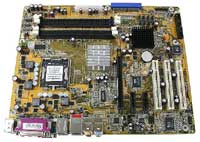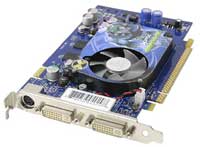Gaming Buyer's Guide - November 2004
by Jarred Walton on November 21, 2004 5:54 PM EST- Posted in
- Guides
Intel Budget Gaming System
At the lowest end of the spectrum, AMD doesn't have quite as much of an advantage in performance over Intel, since the CPU is less of a bottleneck, and there is one item that Intel can offer which AMD cannot (yet): PCI Express. Suffice it to say that especially for die-hard Intel fans, they are not a terrible choice, although they do cost slightly more. Here is our best attempt at matching the Budget AMD system's price and performance.| Budget Intel Pentium 4 System | ||
| Hardware | Recommended Component | Price |
| Processor | Pentium 4 520 2.8 GHz 1MB Cache | 158 |
| Motherboard | DFI 915P-TAG i915P | 118 |
| Memory | 1x512MB Mushkin Basic 2.5-4-4 | 75 |
| Video Card | XFX GeFORCE 6600GT 128 MB | 178 |
| Hard Drive | Seagate Barracuda 80GB EIDE model 7200.7 | 59 |
| Optical Drive | NEC DVD+/-RW Drive Model 3500A | 72 |
| Case and Power Supply | Athenatech A602 Black/Silver with 350W PSU | 62 |
| Display | Samsung 793DF 17 Black/Silver CRT (1280x1024@75 Hz) | 139 |
| Speakers | Logitech Z-640 5.1 | 52 |
| Keyboard and Mouse | Logitech Optical Desktop Combo | 26 |
| Bottom Line | 939 | |
 Click to enlarge. |
 Click to enlarge. |
Another drawback is that dual-channel RAM helps the Pentium 4 more than it does the Athlon 64, so using only one DIMM is going to cut into that performance boost a bit. If you plan on adding 512MB of RAM in the near future, that's not too big of a problem. Otherwise - and we hesitate to say this as they may not be of much use in future systems - using two 256 MB DIMMs will cost about the same as a single 512 MB DIMM. The extra $70 or so spent on an Intel system could be put into other items like a better graphics card or a faster CPU, and AMD also has the 64-bit factor to consider. This is why we still give AMD our primary recommendation, but it really is a close match-up in this price bracket.
Besides shipping PCI Express support, Intel also has their HyperThreading feature, which can help in certain multi-tasking applications. We have not yet seen any performance benefit to HyperThreading in the gaming realm - quite the reverse, in fact, as most games run a few percent slower with HTT enabled - but that could change in the future. With both AMD and Intel shifting away from increasing clock speeds to multi-core designs, it would make sense that games at some point will need to shift to a multi-threaded programming environment in order to extract the most performance from the processor. HTT ends up being nothing that we are overly concerned with as far as games go, but it's still there and it could come into play in the next year or two.
If you feel that our budget recommendations are almost impractical, just take that as an indication of the difficulty of selecting parts for this price segment. These three platforms are all very capable, however, and none of them is truly a bad choice. If you're the type of person who upgrades parts frequently - i.e. more than twice a year - over the life of your system, the socket 939 and socket 775 platforms will be a better choice. From a pure price standpoint, socket 754 still wins out.










70 Comments
View All Comments
benk - Monday, November 22, 2004 - link
The Dell 2001FP is listed at 799 and is often on sale for well below 700.Swaid - Monday, November 22, 2004 - link
Illissius -I was just about to suggest that. The Epox motherboard is a much better "buy" then the Chaintech now.
Illissius - Monday, November 22, 2004 - link
I agree with nearly all the choices, which can't be said for most other buying guides I've read :)My one suggestion is that the EPoX 8KDA3J costs nearly the same as the Chaintech VNF3-250, and has more functionality -- namely, it uses the 250Gb chipset.
kherman - Monday, November 22, 2004 - link
AGP:Anyone wondering aobut when it will be phased out, just look back to old PCI video cards. Took about 1-2 years for manufacturers to drop AGP support altogether. It's a supply demand issue.
As for mobo's I'd expect to see new mobo's w/AGP for atleast a year more. Some people iwll be using those older video cards after all. Also, multiple PCI-X slots are the goal and if I understand correctly, PCI altogether will be dropped, menaing network and sound cards will also need a PCI-X home.
Anyways...my 2 cents.
kherman - Monday, November 22, 2004 - link
How about RAID 5 for the "fully employed" system? Would be redundant and should give slightly faster load times ;)kherman - Monday, November 22, 2004 - link
"Budget Gaming System, Part Two"IMHO: Keep the 2800+ part and spend that extra $50 on a better video card. That will give better frame rates, IMO of course.
JarredWalton - Monday, November 22, 2004 - link
I've heard conflicting reports about the quality of gaming on the Dell 2001FP. Some people love it, and others think it's good but perhaps not great. The price on it is also subject to quite a bit of variation. Right now, I believe it's on sale for about the same as the Viewsonic, while "normally" it might be $1000 plus shipping. I have not actually used one in person, so I can't really comment on interpolation quality, but of the LCDs that I have used, I have yet to see one that offers interpolation of such a quality that I wouldn't hesitate to recommend it. Opinions on that, of course, differ.The same goes for the wireless mouse. Some people swear by the MX510. I've tried it, and I simply did not like it. The Microsoft wireless mice I've tried were even worse, however. Anyway, the choice of mouse is very personal. I really like the standard MS Optical five button. It's light and accurate enough that I don't have any complaints. Even with an unlimited budget, I would still buy that same mouse for my own use. I *could* go out and try numerous other mice, but I'm just not that concerned with that one peripheral. If you are, more power to you! :)
MiLLeRBoY - Monday, November 22, 2004 - link
Also, for the High-End Gaming, check out the new the Logitech Z-5500 Digital speakers. It's just a revamped version of the Z-680's design as well as adding more power. The subwoofer is noticeably larger than the former though. The retail price is $400.MiLLeRBoY - Monday, November 22, 2004 - link
DEMO24 - I have the 20.1" Dell 2001FP and it only has a 16ms response time. However, I don't see ghosting when playing games. I also play my games at 1024x768 with 4xAA when the LCD's native resolution is 1600x1200. The image interpolation is great, it doesn't look horrible even at 1280x1024 or 1024x768. And the price is around the same as the ViewSonic VP912B. However, I probably wouldn't mind using any of those two LCDs, they're both great.xsilver - Monday, November 22, 2004 - link
?? min 18A on 12v rail -- crap my PSU doesn't have that... will it not run a AMDs939? (15A -- enhance brand, respectable, heavy)